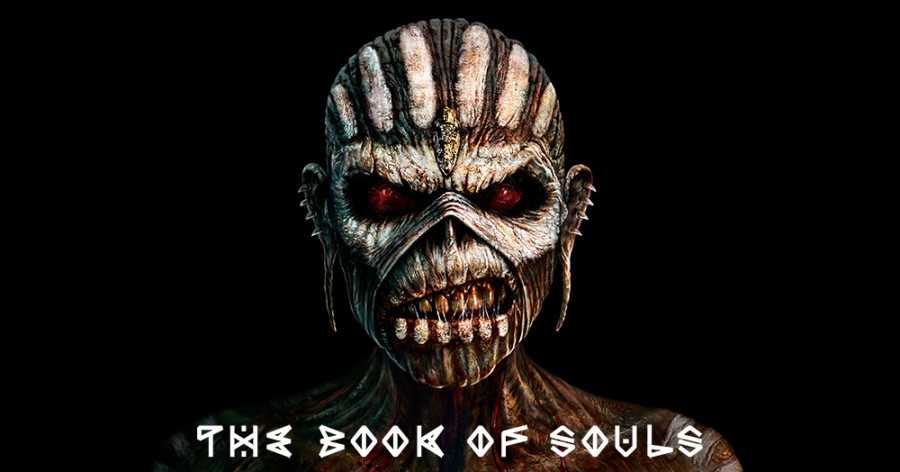Side A: Book of Souls will please most Iron Maiden fans
The cover design of Iron Maiden’s latest album, The Book of Souls.
February 10, 2016
In September of 2015, Iron Maiden released their long-awaited The Book Of Souls, the 16th studio album in their extensive and varied discography.
Heavy metal music, as well as rock in general, has come a long way since its conception in the ‘70s. Much of the evolution and progression that has occurred throughout heavy metal in the last 40 years was due to one particular group; the ubiquitous Iron Maiden. Formed in 1980, these metal veterans have accumulated an ever-growing international fanbase in both the young and old. Opeth, Avenged Sevenfold, and Metallica are just a few groups whose sound and style draws heavily from the classic music of Iron Maiden. Through more than 15 studio releases they have evolved their sound from a heavier reflection of Zeppelin-esque blues rock to a sophisticated and classically-rooted symphonic metal feel.
After 2010’s The Final Frontier, a relatively modest album in sound, the audience might’ve expected a heavier sound and a throwback to the older days of cranking up the gain and volume on classic blues rock, with extensive solo sections and the occasional symphonic sound. It was a bit of a curveball for some, but most found the album enjoyable and tasteful in principle and execution. It may not have been the most original LP ever recorded, but the music was great.
The album started off with the brooding and morose, If Eternity Should Fail, setting the themes carried extensively in later tracks, this song radiates a sense of eccentric mastery, conceptually and sonically. From the use of synthesizers in the beginning to Bruce Dickinson’s bizarre vocals at the end, the song proves a weird but compelling opener. Like most Iron Maiden songs, this piece relies heavily on bass guitar, played by Steve Harris, while guitarists Murray, Gers, and Smith expertly weave around the sound that drummer Nicko McBrain and him establish.
Up next, Speed Of Light is easily the most stand-out track on the album. In contrast with much of the symphonic content on A Matter Of Life And Death (2006), this particular piece shines not in its technical prowess or neoclassical convention but in its similarity to ‘70s Blues Rock; with a Maiden twist of course. Emulating such classic heroes as Deep Purple and Mountain, Speed Of Light is commercially speaking, it was even the most successful track on Book of Souls, as well as being the first single released before September, unleashing of the double-CD LP. Some might’ve liked the song, while others might’ve thought dynamics, articulation, and phrasing in particular were just a bit weak on this track, as it seemed rather monotonous in these respects. The guitar solos could’ve had a little more flair to them, with more musical variety and musicianship.
Track number three, The Great Unknown, was almost a sequel to the opener, If Eternity Should Fail. While not quite as weird or compellingly melodramatic, it continues the gloominess and seriousness depicted in the murky eight-minute piece. Dynamics and articulation were great, and fans were quite impressed with the musicianship on this one. Even though the balance could’ve been better, the bass seemed just a bit weak, especially in melodic songs like this one. The guitar solo felt a bit awkward, but in general the piece was a very nice counterpart to both of the tracks before it. Anyone who has listened a fair amount of Iron Maiden in the past, particularly off of Dance of Death, Brave New World, and A Matter Of Life And Death, might’ve gotten tired of The Red and the Black at the latest by the four minute mark. About two minutes into the song, singer Bruce Dickinson breaks out into a chorus that is nearly identical to many songs that Maiden has written. For example, Rainmaker from Dance Of Death contains the exact same chord progression, musicianship, interpretation, and conceptual theme. The “whoaaaaah” vocal was kind of appealing, yet strangely romantic; even though Maiden has effectively butchered this quaint little idea. However, for those who have enough tolerance to listen to five minutes of complete filler, The Red and the Black proves to be an interesting and compelling piece in the second half. It’s used of minor and major chords in conjunction to create a bittersweet feeling that is original and very pleasing to listen to.
The River Runs Deep is a standard heavy metal tune, with blues chords and a nice guitar part. This was certainly a nice throwback to early Maiden sound, but it didn’t go nearly as far in the direction of Blues Rock as Speed Of Light. As one of the more elaborate songs on the album, it could have used more elaborate drumming, as well as more musicianship from guitar and bass. The title tracks are obligated to be among the best on an album, and should represent the album as a whole well. This particular song did not disappoint, fans were genuinely impressed by this behemoth of a metal symphony, due to instrumental proficiency, good arranging, mixing, and mastering, and musicality.
The title track was a great way to end the first side of the album, as it provided a partial conclusion to much of the tension built up, particularly in If Eternity Should Fail and The Red and the Black. These tracks, contrary to Speed Of Light, seem to exist to make the album as a whole more compelling, rather than to become singles. Yet, this lengthy track is but a precursor to side two of the album, and the monstrous treat that awaits those patient enough to endure side two of the longest album of one of the greatest heavy metal ensembles of all time.








